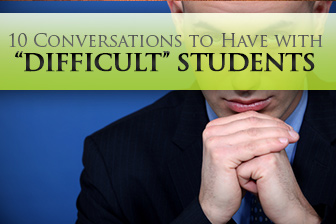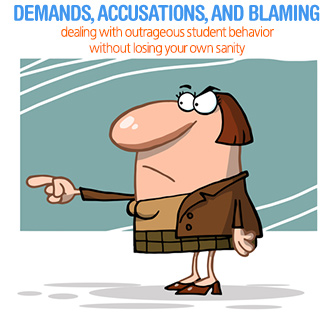We Need to Talk: 6 Conversations to Have with “Difficult” Students


There were about 10 students in class and one no-show—a student that failed to come to any of the live chats, post on the discussion boards, or turn in assignments, and was generally a “phantom” on the roll sheet, despite automatically generated reminders from the university, copied to me, and my own nearly daily updates that went out to her, along with the rest of the class.
I did not lose sleep over the student’s nonappearance, honestly, as it’s fairly common in online classes for adults—students sometimes get busy, forget about their class, or decide it’s not a priority in their rush of adult responsibilities, all understandable. This situation was unusual, however, in that two days before the close of the class, as I was saying good-bye to the students who had chosen to attend and accepting their final projects, I received an email from the no-show student. In this email, she apologized for not checking in before, gave the more-or-less generic “dead grandma” excuse, further elaborated with an explanation that she had been given the wrong information by her advisor and had thought the course was two months long and self-paced, and in signing on, had just realized it was not. She then calmly proceeded to outline a plan for completing the course work in a week.
Somewhat flabbergasted, I emailed her back and told her that wasn’t possible as the course was hard to complete in a regular term, much less a week. This rejection then set off a shower of emails that went on for a couple of weeks, roping in the poor advisor who had given the “misinformation,” the registrar’s office, and the dean of the education department, before it was finally decided Ms. “No-Show” should enroll in a later section of the same course. Throughout it all, the young woman’s tone was hostile, blaming, and entitled: both the advisor and I had done her wrong, and she was entitled to some sort of compensation. Young students shuffling in toward the end of the course claiming confusion and asking to do “make up” work is nothing new, of course. What distinguished this was the young lady’s confrontational tone and entitled attitude—both of which instructors increasing find themselves addressing in students, for a variety of reasons.

It has been noted that there is increasing hostility in general, from “road rage” to workplace shootings, or at any rate, that people express anger more openly than they would have in the past. So the student infuriated at her instructor over some perceived wrong would have in the past vented to her diary or friends but today feels all right about expressing the anger openly.
This more open expression of anger in society leads to the next problem—not knowing how to appropriately express anger. Because it is an emotion that has traditionally been suppressed, not a lot of students know how to appropriately express anger and may engage in a lot of nonproductive behaviors such as yelling or “flaming,” the online equivalent, instead of calmly expressing what they feel is wrong and what they would like to see done.
The world-wide recession, perhaps one of the worst in history, has put a strain on many people, and there is more resultant dysfunctional behavior, like displaced hostility. It is generally easier to vent on your instructor than confront your boss or bank.
The young lady in the anecdote above mentioned in her emails several times how much she had paid for the course—clearly a consumer view—and that this entitled her to certain rights, presumably a grade. This is of course not unnatural, with students more and more taking on sometimes huge debts to go to college, but it also shifts the relationship somewhat from teacher-student to service provider-client.
Along with the consumer view of student-teacher relations comes institutional support for the student—this is the college’s client, after all, and the customer is always right. Twenty years ago if a student claimed temporary insanity or whatnot for her failure to attend class, there would have been little recourse for her as the dean and department chairs may have smiled sympathetically and then told the instructor to go ahead and award the student an “F” as adults are responsible for finding their way to class. Today the initial instinct of the dean was to support the student, agreeing she had indeed been “misinformed” about the class. Again, this change is caused by a differing view of the role of teachers—we are not here to educate but accommodate the “customer” at all costs.

The story after all may be the student’s reality. The student may indeed believe that her advisor and teacher had conspired to misinform her the very month she was devastated by her grandmother’s death. By hearing out the story and redirecting the student to the problem at hand—“I am so sorry all this has happened to you, but how are we going to address your attendance problem?” –the student and teacher can begin to collaborate on a solution.
A mistake I made with the example student is that I got annoyed with her from the outset—that she emailed me as the course was about to end and was so confident everything was going to be okay. This annoyance came out in the emails and probably escalated rather than defused the situation. I will in the future remember to remain as calm, sympathetic, and as objective as possible: “Your grandmother died; that must have been so terrible for you.” Remaining calm will go a long way to defuse the situation, as the student will see you as an ally, not adversary, in solving the problem.
A thing I did correctly in the interaction was limit the interactions to email—a running written record which could be produced to show the student’s hostility or that I had never said she could make up my class, if it became an issue.
Finally, the instructor should not in these situations just refuse the student’s request—although it may be tempting—but be prepared to suggest alternatives, such as taking the course another term. This is likely to leave the student feeling at least partially satisfied.
How do you deal with hostile students?